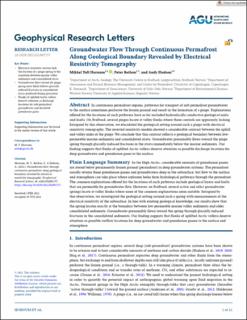| dc.contributor.author | Hornum, Mikkel Toft | |
| dc.contributor.author | Betlem, Peter | |
| dc.contributor.author | Hodson, Andy | |
| dc.date.accessioned | 2022-02-21T10:32:51Z | |
| dc.date.available | 2022-02-21T10:32:51Z | |
| dc.date.created | 2021-08-17T14:31:28Z | |
| dc.date.issued | 2021 | |
| dc.identifier.citation | Hornum, M. T., Betlem, P., & Hodson, A. (2021). Groundwater Flow Through Continuous Permafrost Along Geological Boundary Revealed by Electrical Resistivity Tomography. Geophysical Research Letters, 48(14):e2021GL092757. | en_US |
| dc.identifier.issn | 0094-8276 | |
| dc.identifier.uri | https://hdl.handle.net/11250/2980443 | |
| dc.description.abstract | In continuous permafrost regions, pathways for transport of sub-permafrost groundwater to the surface sometimes perforate the frozen ground and result in the formation of a pingo. Explanations offered for the locations of such pathways have so far included hydraulically conductive geological units and faults. On Svalbard, several pingos locate at valley flanks where these controls are apparently lacking. Intrigued by this observation, we elucidated the geological setting around such a pingo with electrical resistivity tomography. The inverted resistivity models showed a considerable contrast between the uphill and valley-sides of the pingo. We conclude that this contrast reflects a geological boundary between low-permeable marine sediments and consolidated strata. Groundwater presumably flows toward the pingo spring through glacially induced fractures in the strata immediately below the marine sediments. Our finding suggests that flanks of uplifted Arctic valleys deserve attention as possible discharge locations for deep groundwater and greenhouse gases to the surface. | en_US |
| dc.language.iso | eng | en_US |
| dc.publisher | Wiley | en_US |
| dc.rights | Navngivelse 4.0 Internasjonal | * |
| dc.rights.uri | http://creativecommons.org/licenses/by/4.0/deed.no | * |
| dc.title | Groundwater Flow Through Continuous Permafrost Along Geological Boundary Revealed by Electrical Resistivity Tomography | en_US |
| dc.type | Peer reviewed | en_US |
| dc.type | Journal article | en_US |
| dc.description.version | publishedVersion | en_US |
| dc.rights.holder | © 2021. The Authors. | en_US |
| dc.source.pagenumber | 11 | en_US |
| dc.source.volume | 48 | en_US |
| dc.source.journal | Geophysical Research Letters | en_US |
| dc.source.issue | 14 | en_US |
| dc.identifier.doi | 10.1029/2021GL092757 | |
| dc.identifier.cristin | 1926663 | |
| dc.relation.project | Norges forskningsråd: 257579 | en_US |
| dc.source.articlenumber | e2021GL092757 | en_US |
| cristin.ispublished | true | |
| cristin.fulltext | original | |
| cristin.qualitycode | 2 | |

